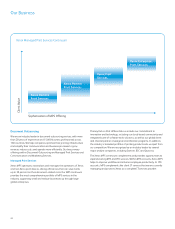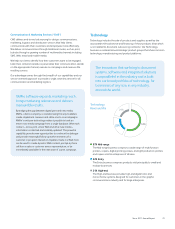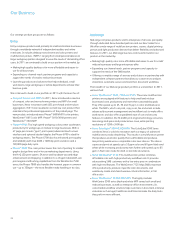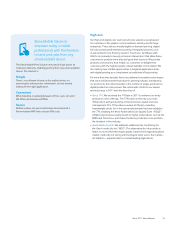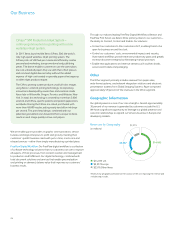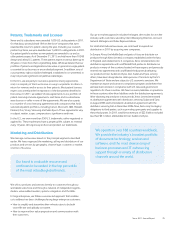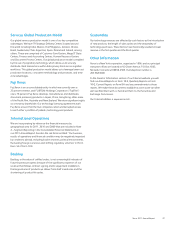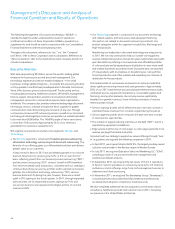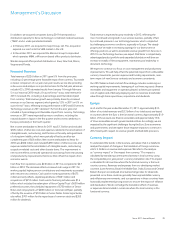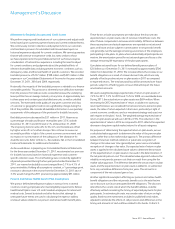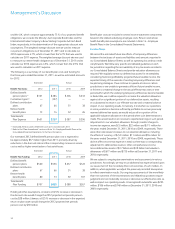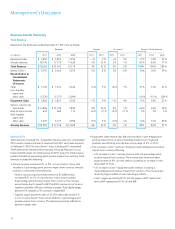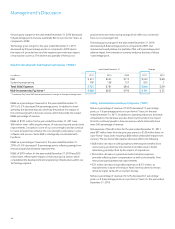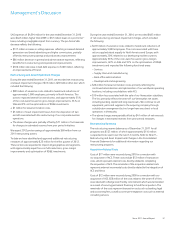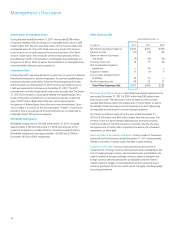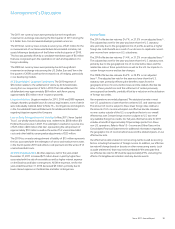Xerox 2011 Annual Report Download - page 32
Download and view the complete annual report
Please find page 32 of the 2011 Xerox annual report below. You can navigate through the pages in the report by either clicking on the pages listed below, or by using the keyword search tool below to find specific information within the annual report.Management’s Discussion
30
Approximately 36% of our consolidated revenues are derived from
operations outside of the United States where the U.S. Dollar is normally
not the functional currency. When compared with the average of the
major European currencies and Canadian Dollar on a revenue-weighted
basis, the U.S. Dollar was 5% weaker in 2011 and 2% stronger in
2010, each compared to the prior year. As a result, the foreign currency
translation impact on revenue was a 2% benefit in 2011 and negligible
in 2010.
Application of Critical Accounting Policies
In preparing our Consolidated Financial Statements and accounting for
the underlying transactions and balances, we apply various accounting
policies. Senior management has discussed the development and
selection of the critical accounting policies, estimates and related
disclosures included herein with the Audit Committee of the Board
of Directors. We consider the policies discussed below as critical to
understanding our Consolidated Financial Statements, as their application
places the most significant demands on management’s judgment, since
financial reporting results rely on estimates of the effects of matters that
are inherently uncertain. In instances where different estimates could
have reasonably been used, we disclosed the impact of these different
estimates on our operations. In certain instances, like revenue recognition
for leases, the accounting rules are prescriptive; therefore, it would not
have been possible to reasonably use different estimates. Changes in
assumptions and estimates are reflected in the period in which they occur.
The impact of such changes could be material to our results of operations
and financial condition in any quarterly or annual period.
Specific risks associated with these critical accounting policies are
discussed throughout the MD&A, where such policies affect our reported
and expected financial results. For a detailed discussion of the application
of these and other accounting policies, refer to Note 1 – Summary of
Significant Accounting Policies in the Consolidated Financial Statements.
Revenue Recognition for Bundled Lease Arrangements
We sell our products and services under bundled lease arrangements,
which typically include equipment, service, supplies and financing
components for which the customer pays a single negotiated monthly
fixed price for all elements over the contractual lease term. Approximately
40% of our equipment sales revenue is related to sales made under
bundled lease arrangements. Typically these arrangements include
an incremental, variable component for page volumes in excess of
contractual page volume minimums, which are often expressed in terms
of price per page. Revenues under these arrangements are allocated,
considering the relative fair values of the lease and non-lease deliverables
included in the bundled arrangement, based upon the estimated fair
values of each element. Lease deliverables include maintenance and
executory costs, equipment and financing, while non-lease deliverables
generally consist of supplies and non-maintenance services. The allocation
for lease deliverables begins by allocating revenues to the maintenance
and executory costs plus profit thereon. These elements are generally
recognized over the term of the lease as services revenue. The remaining
amounts are allocated to the equipment and financing elements, which
are subjected to the accounting estimates noted in “Revenue Recognition
for Leases” in Note 1 – Summary of Significant Accounting Policies in the
Consolidated Financial Statements.
Our pricing interest rates, which are used in determining customer
payments, are developed based upon a variety of factors including local
prevailing rates in the marketplace and the customer’s credit history,
industry and credit class. We reassess our pricing interest rates quarterly
based on changes in the local prevailing rates in the marketplace. These
interest rates have generally been adjusted if the rates vary by 25 basis
points or more, cumulatively, from the last rate in effect. The pricing
interest rates generally equal the implicit rates within the leases, as
corroborated by our comparisons of cash to lease selling prices.
Revenue Recognition for Services – Percentage-of-Completion
A portion of our services revenue is recognized using the percentage-
of-completion accounting method. This method requires the use of
estimates and judgment as discussed below. During 2011, we recognized
approximately $320 million of revenue using the percentage-of-
completion accounting method.
Revenues on certain fixed-price contracts where we provide system
development and implementation services related to our information
technology business are recognized using the percentage-of-completion
approach. Revenue is recognized over the contract term based on
the percentage of development and implementation services that
are provided during the period compared with the total estimated
development and implementation services to be provided over the entire
contract. These contracts require that we perform significant, extensive
and complex design, development, modification and implementation
activities for our clients’ systems. Performance will often extend over long
periods, and our right to receive future payment depends on our future
performance in accordance with the agreement.
The percentage-of-completion methodology involves recognizing
probable and reasonably estimable revenue using the percentage of
services completed, on a current cumulative cost to estimated total cost
basis, using a reasonably consistent profit margin over the period. Due
to the longer-term nature of these projects, developing the estimates of
costs often requires significant judgment. Factors that must be considered
in estimating the progress of work completed and ultimate cost of the
projects include, but are not limited to, the availability of labor and labor
productivity, the nature and complexity of the work to be performed
and the impact of delayed performance. If changes occur in delivery,
productivity or other factors used in developing the estimates of costs or
revenues, we revise our cost and revenue estimates, which may result in
increases or decreases in revenues and costs. Such revisions are reflected
in income in the period in which the facts that give rise to that revision
become known. If at any time these estimates indicate the contract will be
unprofitable, the entire estimated loss for the remainder of the contract is
recorded immediately in cost of service. We perform ongoing profitability
analysis of our services contracts in order to determine whether the latest
estimates require updating.


